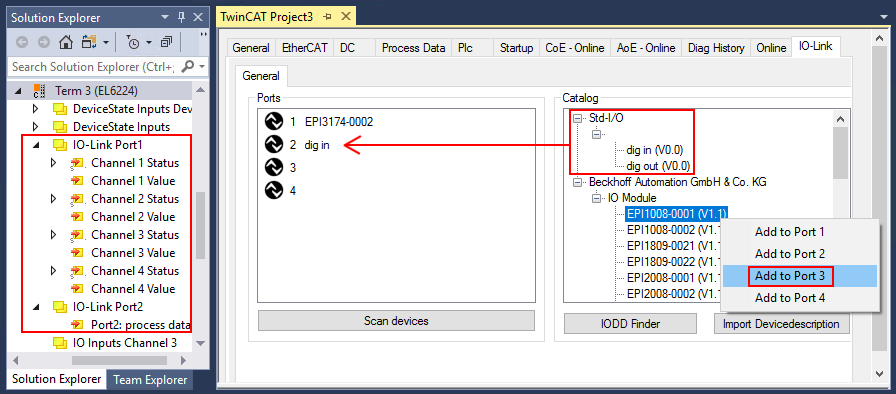2. Assigning IO-Link device to port n
Online configuration
- Requirement: The IO-Link device is connected.
- 1. Press the button Scan devices (see chapter Automatic scanning)
- The device is automatically detected and created with the corresponding parameters. If several devices are stored in the IODD file, the first entry is always selected here. Grouping in the IODD is usually carried out by the vendor if the process data are the same and there are only mechanical differences (e.g. other material).
Offline configuration
The Catalog field shows the IO-Link device catalog, which lists the already imported device descriptions in a tree structure, sorted by vendor.
- 1. Select the desired IO-Link device from the Catalog field
- via drag and drop or
- by right-clicking on the product with "Add to Port n".
Activating the configuration
- 2. Activate the IO link configuration, so that changes become effective.
- The IO-Link devices are displayed, and the process data are created. If an error is found when integrating the IO-Link device, e.g. wrong VendorID or no device connected, then this is indicated via the status of the port (object state Ch.n 0xF100:0n).
Configuration of the IO-Link ports as digital in- or output
IO-Link ports can also be configured as digital inputs or digital outputs. This allows digital sensors and actuators having no IO-Link functionality to be connected to IO-Link ports.
- 1. Expand the "Std-I/O" tree node in the "Catalog" field.
- The operating modes "dig in" and "dig out" appear.
- 2. Configure the desired port. There are two ways to do this:
- Drag-and-drop: pull "dig in" or "dig out" onto the port in the "Ports" field or
- Right-click on "dig in" or "dig out" and click on "Add to Port n“.
Example of port assignment on the IO link master EL6224

Port1: | Port2: | Port3: |
Process data of Port1 and Port2 are displayed in the Solution Explorer. | ||